Speech The Transformation in Maturity Transformation

Philip Lowe[*]
Deputy Governor
Address to Thomson Reuters' 3rd Australian Regulatory Summit
Sydney –
Thank you very much for the invitation to be part of Thomson Reuters' Third Australian Regulatory Summit.
There is no shortage of things to talk about at such a summit. As you are all too aware, there has been a large wave of new regulatory requirements over recent years. The task of adjusting to these new requirements has been a time-consuming one for many of you and that task is not yet over.
This wave of regulation, of course, has not just materialised out of thin air. Rather, it has been in response to the lessons learnt from the financial crisis. That crisis was extremely damaging for the citizens of many countries and the subsequent spotlight on financial institutions has highlighted not just poor risk-management practices but also some serious lapses in governance and ethics. As the various problems have emerged, they have strained the bonds of trust that are so important in finance. In response, regulators, and financial institutions themselves, have sought to reduce the probability of a repeat of the crisis and to rebuild trust in finance. On both accounts, there is still some way to go.
If we look through all the detail of the various regulatory initiatives – and there is certainly a tremendous amount of detail – many of the specific measures stem from the desire to address risks that arise when the financial system undertakes maturity transformation – that is, when it transforms illiquid longer-term assets into liquid assets. So today, rather than go through the long list of regulatory reforms, I would like to focus my remarks around the way in which the financial system undertakes maturity transformation.
Maturity Transformation and the Banking System
The transformation of claims over fundamentally illiquid assets into claims that are highly liquid is one of the critical functions that the financial sector provides for the community. Without such transformation, it is difficult to see how modern economies would work. This transformation has been critical to the accumulation of physical capital in our societies as well as the operation of our modern payment systems.
The best, and most obvious, example, of this type of transformation is an at-call bank deposit.[1] The holder of a deposit has a completely liquid claim on the bank – the full face value of the deposit can be drawn on at any time, for any purpose. Yet deposits are primarily invested in assets, namely bank loans, which, typically, are not particularly liquid and have long maturities. And, in turn, these bank loans fund the creation of real assets in the economy, which themselves are also not particularly liquid.
Of course, banks are not the only institutions that facilitate maturity transformation. Many collective investment vehicles offer a degree of liquidity to investors, but invest in assets that are not particularly liquid. A mutual fund that invests in real estate is a good example of this. Another example of sorts is the listed equity market. Share investors hold equity claims over firms' assets. Under a range of conditions, these claims can be traded for cash at relatively short notice, even though the underlying assets are not particularly liquid.
So, in a sense, both these examples share a similarity with bank deposits. Both are ways of giving savers relatively liquid claims on what are often intrinsically illiquid assets.
There is, however, at least one very important difference. And that is that the bank promises to pay back the deposit in full. In contrast, in the other two examples, there is no such promise and the value of the investment moves up and down with the performance of the underlying assets.
For bank deposits (and other short-term bank liabilities), this combination of maturity transformation and the promise to redeem at par sets up a potentially unstable situation. You can think of there being two possible states of the world. In the first – and usual – state, depositors have confidence that the bank is able to meet its liabilities and everybody is happy. In the second, there are concerns about the ability of the bank to meet its promise to repay in full and on demand, and depositors seek to withdraw their funds. Under some circumstances, this may force the bank to liquefy its assets, potentially at fire-sale prices, which can then worsen the bank's financial position. A fire-sale in one class of assets can also cause stress to be transmitted across the system, with liquidity drying up in other asset classes amid a general rise in uncertainty.
These risks are more than just theoretical possibilities. We saw these dynamics play out in a number of countries during the financial crisis in 2008. We saw some bank runs and, more importantly, runs by holders of short-term bank paper. We saw institutions trying to sell assets in a hurry, sometimes at substantial discounts to their earlier prices. And we saw markets freeze.
In Australia, fortunately, we did not experience the severe problems witnessed elsewhere. However, when global markets froze, the Australian banks, like banks right around the world, could not access those markets. And while we had no high-profile depositor runs, we did see a general increase in nervousness by depositors, resulting in a significant lift in the demand for banknotes (Graph 1).[2] Both these issues were ultimately addressed with a public-policy intervention during the peak of the crisis in October 2008. The first was with the government being prepared to guarantee bank wholesale funding for a fee. And the second was an enhancement of depositor protection arrangements through a guarantee of bank deposits of up to $1 million. These actions followed similar steps to reassure investors and depositors in a number of other countries.
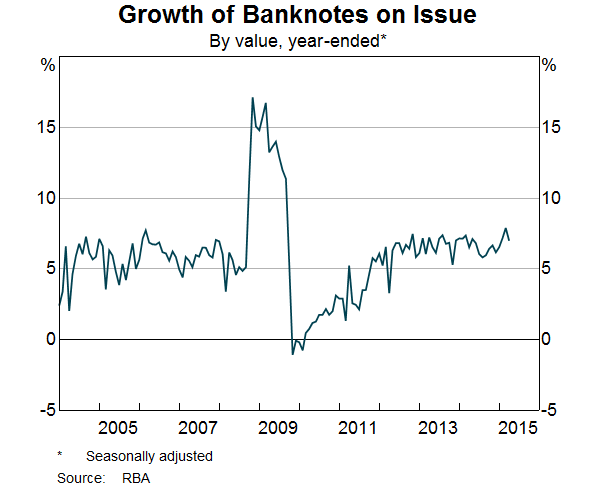
This whole experience, both in Australia and elsewhere, has rightly shone the spotlight on the risks associated with maturity transformation. Prior to the crisis, many people were working under the implicit assumption that markets would always remain open and that financial assets could always be traded at reasonable prices. This assumption turned out to be incorrect. And, in response, it is entirely appropriate that stronger and more resilient arrangements be put in place.
The various efforts have focused on two main areas. The first is strengthening bank balance sheets by increasing the amount and quality of capital in the banking system. By doing so, investors should have greater confidence that banks will be able to meet their liabilities under a broad range of adverse scenarios. The Australian banking system is part of this global trend to higher and better quality capital, with an increase in common equity lifting the aggregate capital ratio from around 10½ per cent prior to the crisis to around 12½ per cent at end 2014 (Graph 2). The recent capital announcements by some of the large banks will see this ratio rise further.
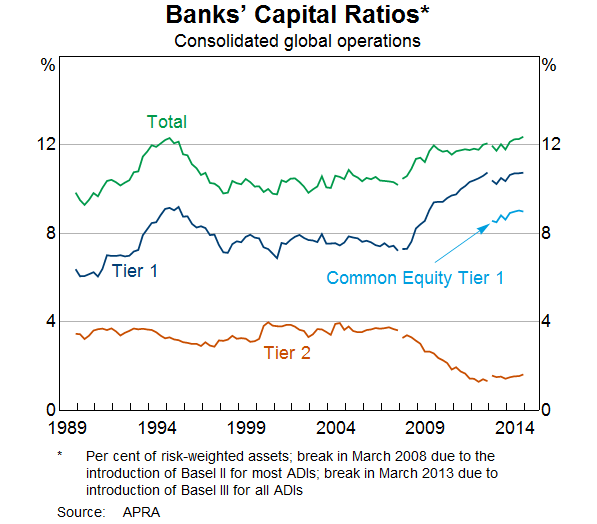
The second, and obvious, area of regulatory focus has been on liquidity management. Here, there have been two main initiatives.
The first is the introduction of a Liquidity Coverage Ratio (LCR) which, from the start of this year, has required banks to hold enough high-quality liquid assets to meet a stress scenario that lasts for 30 days.[3] The challenge for the Australian banking system has been that the supply of such assets is limited due to the stock of government bonds on issue being small relative to the overall size of the financial system. To overcome this challenge, the RBA has provided banks with a Committed Liquidity Facility (CLF) under which it will make available sufficient liquidity (against eligible collateral) to address the shortfall in required holdings of high-quality liquid assets. The pricing of the CLF is aimed at replicating the cost of holding a sufficient volume of these assets, were they to be available in the marketplace.[4] APRA administers the decisions as to which banks access the program, and the maximum amount available to each bank.
The second initiative is the Net Stable Funding Ratio (NSFR), which has a longer-term focus. It will establish a minimum amount of stable funding based on the liquidity characteristics of an institution's assets and activities over a one-year horizon. The new requirement here will not come into effect until January 2018.
This increased focus on liquidity is clearly evident in the balance sheets of the Australian banks. On the assets side, holdings of liquid assets have increased substantially, after they declined for many years (Graph 3). Australian dollar denominated liquid assets are now equivalent to about 7 per cent of banks' total assets, up from around 1 per cent in early 2008 (Graph 3). If the CLF is added in, the current figure is around 15 per cent.
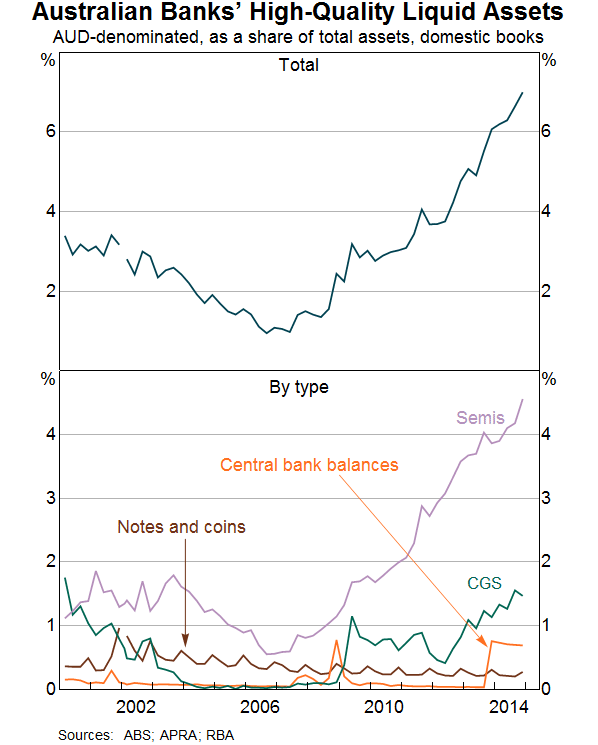
There have also been significant changes on the liabilities side of the balance sheet. The most noticeable has been a shift away from short-term wholesale debt towards deposits (Graph 4). In early 2008, deposits accounted for around 40 per cent of the Australian banks' total funding. Today, that figure is just a little below 60 per cent. In part, this switch has been driven by the judgement that the risk of a run by depositors is less than the risk of a run by investors in short-term wholesale debt. To the extent that this judgement is correct, this switch has increased the effective maturity of banks' liabilities in a stress event, even if it has not increased the contractual maturity.
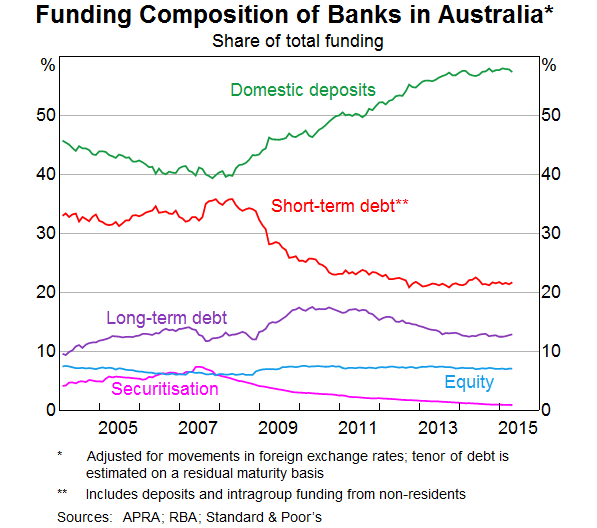
There has also been some lengthening in the average contractual maturity of the various types of liabilities. The share of deposits at the major banks with a maturity of less than three months has declined since 2007, although this share has increased a little more recently as competition for term deposits has waned (Graph 5). Similarly, there has been a noticeable increase in the maturity of banks' other debt liabilities since 2007 (Graph 6). Of particular note, the share of other debt liabilities with maturities of less than three months has declined substantially.
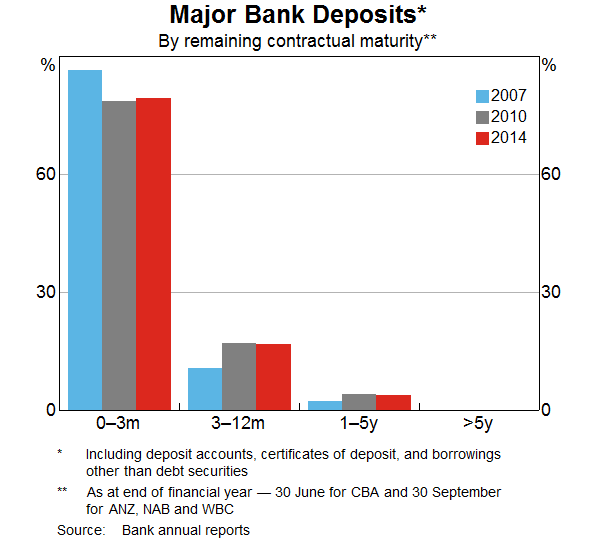
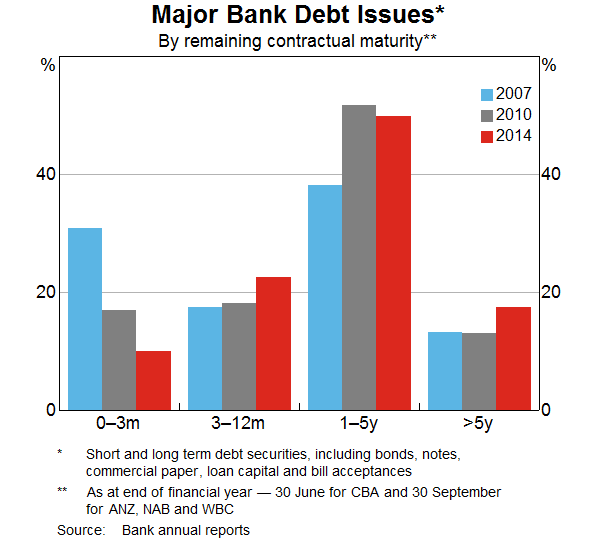
Taken as a whole, these measures have made the system more resilient. We are, though, yet to see how these various changes play out over the medium term. There is no doubt that they have increased the cost of financial intermediation somewhat. They have also increased the likelihood that such intermediation will take place outside the banking sector. After all, to some extent this is what was intended. So we need to keep a close eye on how the overall system responds and make sure that in addressing the very real risks associated with maturity transformation, that we don't create a new set of risks. This is likely to be an ongoing challenge for us all.
It is also important to point out that while the various measures have made the system more resilient, they do not guarantee stability. Because of the very nature of the business that banks undertake, they can still find themselves in a liquidity crisis. Here the role of the central bank acting as a lender of last resort is critically important.
A central bank has the unique ability to effectively liquefy assets so that a bank can meet its liabilities (so long as its assets exceed those liabilities). Provided appropriate collateral is taken and appropriate haircuts are in place, it can do this without incurring material credit risk. In so doing, the central bank can provide society with an efficient and low-cost form of insurance against a liquidity crisis in the banking system. Indeed, it is a longstanding role of central banking to do exactly this. And it is a role that the RBA can, and is, prepared to play.
Maturity Transformation in the Asset Management Industry
But as I said before, banks are not the only institutions that undertake maturity transformation. Understandably, the sharper focus on liquidity risks has led to the question of whether the maturity transformation that is undertaken elsewhere in the system raises similar concerns. And the focus here has fallen very much on the asset management industry and its involvement in financial markets.[5]
This focus reflects a couple of factors.
The first is a structural one. And that is that the pool of assets managed by the asset management industry has grown substantially relative to the size of the economy. In Australia, for example, in the early 1990s the assets in managed funds were equivalent to around 40 per cent of GDP (Graph 7). Today, the figure is 125 per cent. And globally, asset managers are estimated to have around US$76 trillion in assets under management, equivalent to around 55 per cent of global banking assets.[6] So the industry is very large, and it is getting larger. Long-term forces, such as ageing populations and increased wealth, are important factors here, though the changes in the banking system that I have just spoken about have played a role more recently.
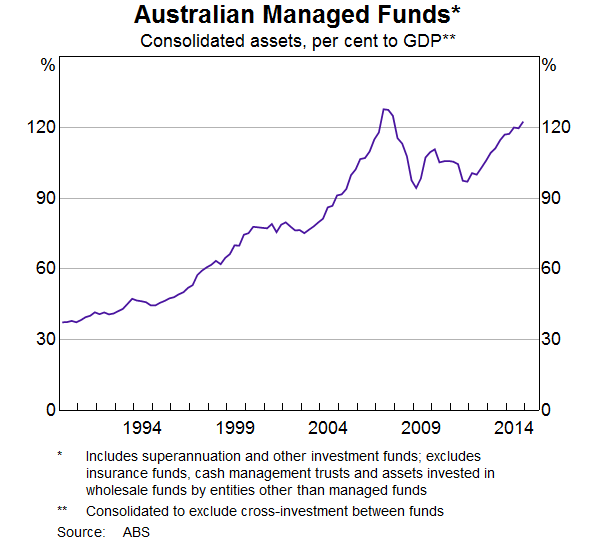
The second factor has a more cyclical element to it. And that is a concern about the possible fallout from the search for yield that has resulted from the very low global interest rates. Money has flowed into collective investment vehicles that invest in a range of higher-yielding assets, including those in emerging markets. Many of these vehicles allow investors to redeem their funds at short notice, even though the underlying assets are not particularly liquid, and are likely to be even less liquid at a time when there are large-scale redemptions. This has occurred at a time when liquidity has declined in some markets, partly in response to a lower appetite for risk and tighter financial regulation.[7] This combination of developments raises the question of what might happen in stressed conditions.
This increased focus on the asset management industry has seen a number of bodies either commission or issue reports on the industry over recent times. These bodies include the International Monetary Fund, the Financial Stability Board and the International Organization of Securities Commissions, and the US Financial Stability Oversight Council.[8] It has become quite a crowded field!
The underlying concern is not that these vehicles will be unable to meet their obligations to their investors, but rather that they could serve to spread distress across the broader financial system. Two features of these vehicles, in particular, have drawn attention. The first is the ease of redemptions even when the underlying assets are illiquid. And the second is the possible misalignment of incentives between the portfolio manager and the end investor, which could amplify shocks. These concerns have sparked a lively debate as to what, if anything, should be done.
This is an area where Australia does have some relevant experience.
In particular, in the past 25 years we have had two episodes where there have been significant runs on collective investment vehicles.
The first was in the early 1990s and initially involved a run on mortgage trusts operated by Estate Mortgage. It followed a boom and subsequent emerging bust in the commercial property market. The run came to an end when redemptions were frozen by the National Companies and Securities Commission, a forerunner of ASIC. Subsequently, there were runs on a number of unlisted property trusts operated by other non-banks, with investors seeking to withdraw their funds prior to the periodic (and downward) reduction in unit prices. These runs eventually spread to trusts operated by banks. This led to fears that suspensions in these bank-operated trusts would spark a generalised loss of confidence in the banking system, which at the time was already under some strain. In response, the Australian Government announced a 12-month freeze on all redemptions from unlisted property trusts.[9]
The second episode is much more recent and occurred during the peak of the financial crisis in 2008. Again, it involved property-related trusts. As uncertainty rose and conditions in property markets deteriorated, investors began to withdraw funds. These redemptions accelerated in mid-October 2008 after the announcement of the guarantee on bank deposits. In response, most mortgage trusts froze redemptions, with estimates of up to $30 billion being affected by freezes at that time. Subsequently, ASIC worked with the funds' administrators to provide limited withdrawals for investors in hardship cases.
Looking back at these experiences and the current international discussions, there are five brief observations that are perhaps useful to make.
The first is the importance of investors understanding the nature of the liquidity promise that is being made. In normal conditions, many collective investment vehicles have the ability to offer a high degree of liquidity despite the bulk of the underlying assets being illiquid. But in stressed conditions, this ability can disappear quickly. This needs to be clearly understood by both investors and fund managers. This has not always been the case.
The second is the benefit of clear rules around the process for freezing redemptions, including who is responsible for making these decisions. After the early 1990s experience, there was a change in legislation in this area. Under the current Corporations Act 2001, responsible entities must suspend withdrawals from a retail fund if ‘liquid assets’ are less than 80 per cent of total assets, which should help to guard against fire-sales.[10] While in some other countries, responsible entities have a similar ability to freeze redemptions, it is not always compulsory for them to do so.
The third is the importance of appropriate separation between bank-managed investment funds and the bank owners. APRA has prudential requirements for banks to address potential contagion risk between other members of the group. This includes clear disclosure that the group member is not a bank, and that the bank does not stand behind the group member – unless there is a formal legal agreement that is prominently disclosed. APRA also reserves the right to require an entity not to use a particular brand name if it would give rise to prudential concerns. Clear disclosure and branding reduces the probability that a redemption freeze in a bank-related investment fund would cause depositors to worry that their deposits will also be frozen. In Australia, the fund management arms of the major banks now largely have separate brands, but this is not always the case in other countries.
The fourth observation is the importance of frequent updating of unit prices. The early 1990s experience illustrated the problems that can arise when there is a lag between changes in the value of the underlying assets and in unit prices, thereby creating an additional incentive to redeem in a falling market. Over time, there has been a move to much more frequent updating of prices in Australia, with funds now typically updating prices daily.
The fifth and final observation is that, at least in these two examples, the runs and subsequent freezes did not lead to systemic problems in the financial system. In neither case was there a significant fire-sale of assets. The unit prices declined and investors experienced losses as the value of the underlying assets declined. This did not lead to stability issues in the broader system, although the freezes did cause hardship for some individual investors.
So our own experience is that these types of disruptions in the asset management industry can be managed. However, the degree to which this lesson can be applied more broadly remains to be seen.
Globally, there is considerable effort being devoted to understanding the nature of the risks in this area, including whether these risks are any different to those that would arise if investment portfolios were managed directly by the individual investors themselves, without the input of an asset manager. A related stream of work – which in some way parallels similar work for the banking industry – is to examine what role regulation should play in addressing the various risks and what role the central bank should play. Relevant issues here include: how prescriptive any liquidity regulations should be; what are the merits of alternatives to fund freezes, such as exit fees and liquidity gates; and what, if any, role should the central bank play when markets freeze and normally liquid assets cannot be traded.
These are all difficult issues to deal with and perspectives range widely. I am sure that they will keep many of us busy over the years ahead.
On that note, I would like to thank you for listening and I would be happy to answer any questions.
Endnotes
I would like to thank Fiona Price and Carl Schwartz for assistance in the preparation of these remarks. [*]
The term bank is used for simplicity, though in the Australian context this applies to authorised deposit-taking institutions, encompassing banks, building societies and credit unions. [1]
See Cusbert and Rohling (2013). [2]
See APRA (2013) and APRA (2014) for further details on the LCR. [3]
See Debelle (2014) for further details. [4]
A fuller discussion of these issues can be found in Price and Schwartz (2015). [5]
This estimate of assets under management, taken from IMF (2015), is based on the world's top 500 asset managers at the end of 2013. It includes some double-counting due to cross-investment among asset managers. [6]
See Cheshire (2015). [7]
See FSB & IOSCO (2015), FSOC (2013) and IMF (2015). [8]
This account is drawn from Gizycki and Lowe (2000). [9]
‘Liquid assets’ refers to assets including cash, bills, marketable securities or other property that the responsible entity reasonably considers able to be realised for its market value within the period provided for in the scheme's constitution for satisfying withdrawal requests. [10]
References
APRA (Australian Prudential Regulation Authority) (2013) ‘Implementing Basel III liquidity reforms in Australia’, APRA Discussion Paper, May. Available at <http://www.apra.gov.au/adi/PrudentialFramework/Pages/Implementing-Basel-III-liquidity-reforms-in-Australia-May-2013.aspx>
APRA (2014), ‘APRA Finalises Implementation of Liquidity Coverage Ratio in Australia’, Media Release No 14.22, 4 November. Available at <http://www.apra.gov.au/MediaReleases/Pages/14_22.aspx>.
Cheshire J (2015), ‘Market Making in Bond Markets’, RBA Bulletin, March, pp 63–73.
Cusbert T and Rohling T (2013), ‘Currency Demand during the Global Financial Crisis: Evidence from Australia’, RBA Research Discussion Paper No 2013-01.
Debelle G (2014), ‘Liquidity’, Speech at the 27th Australasian Finance and Banking Conference, Sydney, 16 December.
International Monetary Fund (2015), The Global Financial Stability Report, Chapter 3, April. Available at <https://www.imf.org/External/Pubs/FT/GFSR/2015/01/index.htm>
Financial Stability Board and International Organization of Securities Commissions (2015), Assessment Methodologies for Identifying Non-Bank Non-Insurer Global Systemically Important Financial Institutions', consultative document (2nd), March. Available at <http://www.financialstabilityboard.org/wp-content/uploads/2nd-Con-Doc-on-NBNI-G-SIFI-methodologies.pdf>
Gizycki M and P Lowe (2000), ‘The Australian Financial System in the 1990s’, in D Gruen and S Shrestha (eds), The Australian Economy in the 1990s, Proceedings of a Conference, Reserve Bank of Australia, Sydney, pp 180–215.
Price F and C Schwartz (2015), Recent Developments in Asset Management, RBA Bulletin, June, forthcoming.
United States Financial Stability Oversight Council (FSOC) commissioned: Office of Financial Research (2013), ‘Asset Management and Financial Stability’, September. Available at <http://financialresearch.gov/reports/files/ofr_asset_management_and_financial_stability.pdf>